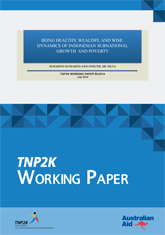Being Healthy, Wealthy, and Wise: Dynamics of Indonesian Subnational Growth and Poverty
Working Paper 09-2014
Authors : Sudarno Sumarto and Indunil de Silva
The aim of this study is twofold. First, despite the vast empirical literature on testing the neoclassical model of economic growth using cross-country data, very few studies exist at the subnational level. We attempted to fill this gap by using panel data for 2002–12, a modified neoclassical growth equation, and a dynamic-panel estimator to investigate the effect of both health and education capital on economic growth and poverty at the district level in Indonesia. Second, although most existing cross-country studies tend to concentrate only on education as a measure of human capital, we expanded the analysis and probed the effects of health capital as well. As far as we are aware, no study has done a direct and comprehensive examination of the impacts of health on growth and poverty at the subnational level. Thus, this study is the first at the subnational level, and our findings will be particularly relevant in understanding the role of both health and education capital in accelerating growth and poverty reduction efforts.
The empirical findings are broadly encouraging. First, nullifying any doubts on the reliability of Indonesian subnational data, our results suggest that the neoclassical model augmented by both health and education capital provides a fairly good account of cross-district variation in economic growth and poverty in Indonesia. We found that the results on conditional convergence, physical capital investment rate, and population growth confirm the theoretical predictions of the augmented neoclassical model. We also found that both health and education capital had a relatively large and statistically significant positive effect on the growth rate of per capita income. Economic growth was found to play a vital role in reducing Indonesian poverty, reinforcing the importance of attaining higher rates of economic growth. Findings from the poverty–human capital model showed that districts with low levels of education are characterized by higher levels of poverty. We found that regions with mediocre immunization coverage and greater than average prevalence of waterborne diseases had higher poverty rates and lower output per capita. Similarly, regions with higher numbers of births attended by a skilled birth attendant were associated with lower poverty rates and higher economic output. Our results in particular suggest that, in designing policies for growth, human development, and poverty reduction, it is necessary to broaden the concept of human capital to include health as well.
To request copies of the report or for more information on the report, please contact the TNP2K Knowledge Management Unit (kmu@tnp2k.go.id).
